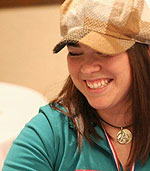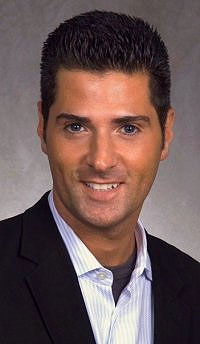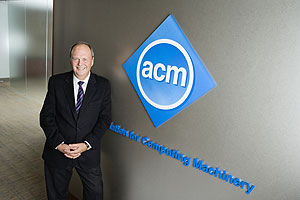REDMOND, Wash. — April 22, 2010 — Several years ago, Erin “Ed” Donahue was goaded by her mom into taking a computer science class. At the time Donahue was a sophomore at DePauw University in Greencastle, Indiana, preparing for a career in international business. Her mom would repeatedly mention that her cousin had taken the same course and wound up working at Microsoft, even though her degree was in biology. Finally, Donahue, a self-described math geek, thought why not and registered for the intro class.

Erin Donahue, who attended last year’s U.S. Imagine Cup Finals, today helps track satellites as a software development engineer at Lockheed Martin.
Halfway through the semester, she found herself enjoying the logic and rules of computer science much more than the pain of her financial accounting course. One day her professor handed back a test, which she had aced. On it she had written Donahue a short note: “Great job. Do you have a major?”
Right then Donahue decided to ditch economics. She didn’t exactly know what kind of job she’d end up in, but she thought her options would be wide open with a degree in computing.
“I thought, ‘Well, if my cousin could do it in biology, then I’m pretty sure I could figure something out if I actually majored in computer science,’” says Donahue, who today helps track satellites as a software development engineer at Lockheed Martin. “I think one of the really big ways to get more people interested in technology is to talk about this interdisciplinary talent that computer science has.”

Anthony Salcito, Microsoft’s vice president of Worldwide Education.
The message that computing can unlock a wealth of opportunities needs to be delivered to more young students, says Anthony Salcito, Microsoft’s vice president of Worldwide Education. One way Microsoft tries to help spread that message is through events such as the Imagine Cup, a worldwide competition that urges students to use technology to create innovative solutions that can change the world, he says. The U.S. Imagine Cup finals kick off this weekend in Washington, D.C., with the winner advancing to the worldwide finals in Poland in July. The competition is sponsored by Microsoft.
On the eve of the U.S. Imagine Cup finals, Salcito says that the country needs to do much more to get kids interested in technical fields, pointing out that no U.S. team has ever won the Imagine Cup.
“There are a lot of amazing students doing amazing projects across the United States, but other countries have done a better job of celebrating and nurturing these students early on,” Salcito says. “What we need to do is make sure that technology is a right, not a privilege, for every student and then challenge them to be great. If we do that we’ll be successful as a country.”
Salcito says helping U.S. students get more competitive in science and math is a priority for Microsoft. One way to do that, he said, is to get more American students interested in the Imagine Cup, which is why there is a greater focus on this year’s competition.
“We need to do a better job of exposing kids to the power of technology to create their own careers, and the Imagine Cup is a platform of exposing that to students in high school and college,” he says.

John White, chief executive officer of the Association for Computing Machinery.
Concern about U.S. competitiveness extends beyond student competitions. To remain competitive as a country, the United States must maintain a pipeline of students interested in computing and other technical subjects, says John White, chief executive officer of the Association for Computing Machinery (ACM).
“If you look at innovative breakthroughs in different industries and what’s going on in the world, computing and disruptive events in the informational technology space are fundamentally important to innovation and success in the global economy,” White says.
For decades, the U.S. remained a leader in innovation thanks to investment in education as well as in research and development, White says, but as the role and significance of computing has grown, the teaching of computer science in K-12 has faded. Between 2005 and 2009, the percentage of high schools offering rigorous computer science courses fell from 40 percent to 27 percent, according to the ACM. The percentage of schools even offering an intro class fell from 78 to 65 percent.
Some of the problems that Microsoft, ACM and others are working to combat are systemic, White says, such as schools shuffling teachers capable of leading advanced classes to remedial courses. But the computing field also suffers from an image problem, he says. Some parents, teachers and high school counselors believe there’s no future in the IT industry, a byproduct of the dot-com bust and offshoring of jobs. But the U.S. Bureau of Labor Statistics has estimated that five of the 10 fastest-growing jobs will be in computing-related fields. By 2016, more than 800,000 high-end computing jobs will be created in the economy, making it one of the fastest growing occupational fields.
White says the field also needs to combat the image of an isolated programmer pounding out code. “The fact that you study computer science doesn’t mean you’re going to be a software engineer at Microsoft or Google,” he said. “It means you have the skill set to take on any career because computing underpins everything.”
Salcito says that one reason the theme of the Imagine Cup has shifted is to show that computing has the potential to change the world. This year, teams are trying to use technology and their creative ideas to solve some of the world’s toughest social problems as outlined in the United Nations’ Millennium Development Goals. The hope is to broaden the appeal of a career in computing.
“I love the fact that the Imagine Cup doesn’t just say, ‘build a science project,’ but rather encourages students to fight hunger and disease,’” he says. “We’re giving students big challenges to help solve through complex uses of technology, and I think that inspires and motivates students. It shows them not only our faith in them to deliver big for the world but the reality that these problems are what they’ll be solving in their careers.”
Last year, Erin Donahue was part of the Mango Bunnies, the first all-female team that went to the U.S. Imagine Cup finals. She says the team was inspired to work on a project with the potential to help others. “As we were brainstorming ideas, we realized that the benefit of these projects was going to be more than just a grade at the end of the semester,” she says. “It was really cool to work on something that was dynamic and could maybe make a difference.”
Events such as the Imagine Cup are important because they show students the wealth of opportunities available to them through computing, White says. It’s a message that must be broadcast if the U.S. is to remain competitive in the digital age.
“Studying computer science doesn’t necessarily mean that you’ll work for a computer company, but it does means that you’ll have the education, resources and understanding to basically do anything in a future career,” White says. “It’s a fundamental skill and knowledge set for the 21st century.”




